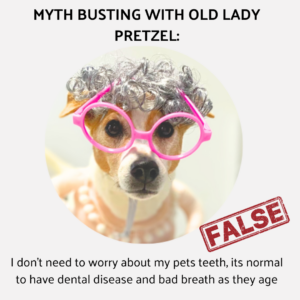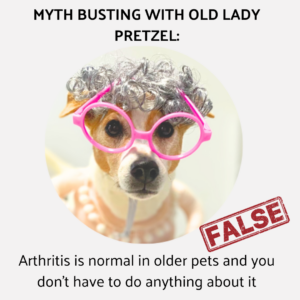
As our pets age they may slow down, they may start to feel stiffness and pain, and they may be more prone to certain health conditions. It is important to remember that pet health and medicine has come a long way and your pet does not need to suffer or loose quality of life as they age. Thanks to more educated pet parents, and better health care, pets are living longer than ever before so lets all work together to ensure that our pets stay happy and healthy, even as they age.
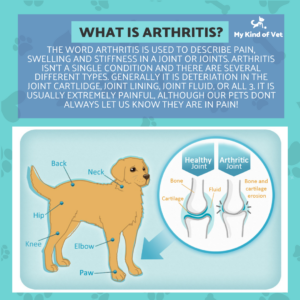
What is arthritis?
Getting old can mean slowing down, but it does not have to mean pain for your pet! Pain is not normal, or ok for an older pet.
The word arthritis is used to describe pain, swelling and stiffness in a joint or joints. Arthritis isn’t a single condition and there are several different types. Generally it is deterioration in the joint cartilage, joint lining, joint fluid, or all 3. It is usually extremely painful, although our pets don’t always let us know they are in pain!
Osteoarthritis is one of the most common causes of joint pain in pets. Although there is no cure for arthritis, proper treatment and nutrition can remove or minimise pain and slow down progression.
Symptoms can include slowing down, limping, aversion to stairs, difficulty standing or walking, showing pain when picked up, licking or chewing at the aching joint, and irritability.
If your pet is experiencing symptoms of joint pain, talk to your veterinarian about the best treatment to keep your pet comfortable. There are many great relief options for pets with arthritis now so there is no need for them to suffer.
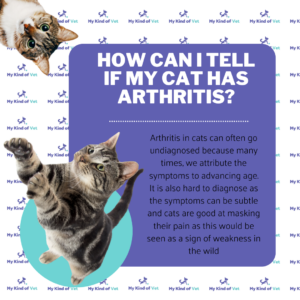
What about cats in particular?
Arthritis in cats can often go undiagnosed because many times, we attribute the symptoms to advancing age. It is also hard to diagnose as the symptoms can be subtle and cats are good at masking their pain as this would be seen as a sign of weakness in the wild.
The following are some signs that your cat may have arthritis:
* Reluctance to jump up or down;
* Walking stiffly, or with a limp;
* Unexpected aggression toward other cats or humans;
* Hiding more than usual;
* Heavy licking near a specific joint or area;
* Urination/defecation outside the litter box;
* Laying down to play, especially if they were previously a very active cat;
* Decreased self-grooming or matted fur
If you suspect your cat may have arthritis or pain, book an appointment with your vet
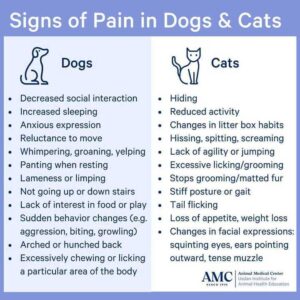
Identifying pain in your pets:
Do you know how to identify pain in your pet? Often symptoms of pain are quite subtle and hard to identify. It is important to closely monitor what is normal for your pet, and note any changes, no matter how slight.
Too often we hear things like: “They are limping, but they are not in any pain”. The truth is, they would not be limping if they weren’t in pain… if they are limping, they are definitely in pain! Some people believe that unless an animal is audibly crying and whimpering, or not moving at all then they aren’t in pain! Please spread awareness, this is definitely not the case. Don’t let any animal suffer due to a lack of knowledge, share this around!
Our pets cannot tell us how they are feeling so be their voice and advocate.
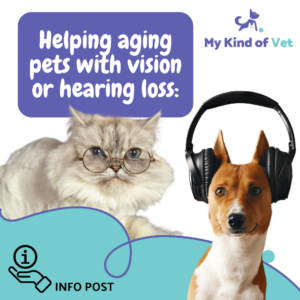
Blind and/or Deaf Dogs
Tips for living with blind and deaf dogs:
The level of your dog’s disability might vary. They might be completely deaf or blind, or just have reduced ability. Either way, considerate communication will help your dog to understand the world around them. This, in turn, will help them to cope and adjust and continue to live happily and with good quality of life.
As with any dog, it’s important to be consistent with any rules and routines you have put in place for them. This is especially important with deaf and blind dogs. They are likely to be more easily startled, so it’s helpful for them to be able to predict what is going to happen.
Make sure you can recognise signs of fear or anxiety in your dog. Being able to recognise how your dog is feeling will help you to respond appropriately.
Deaf dogs
Here’s how to make life better for you and your pooch.
1) Be considerate
Like all dogs, deaf dogs will be startled if touched when they are not expecting it, so avoid disturbing them when they’re asleep. But deaf dogs will require similar consideration even when awake. You need to gently get their attention without scaring them. Gaining a deaf dog’s attention when they aren’t looking at you can be a challenge!
Where possible, move your position so that you are in their line of vision. You could also try using light as a way to get their attention. But be careful not to shine the light directly into their eyes.
2) Let them know where you are
Deaf dogs might worry about where you are if you leave the room without them seeing. It might be helpful to move past them on your way out so they can watch where you go. Or you could use a signal like opening and closing the door. Deaf dogs can feel vibrations and can over time learn what these mean within the environment. They might learn to link the vibration of a door opening with you coming into a room.
3) Make touch positive
Dogs communicate through touch, and deaf dogs even more so, so it needs to be a positive experience. Try not to interact with your dog when you are feeling frustrated or angry. They are likely to sense this feeling from you and become worried or confused as they can’t understand why you’re feeling this way.
4) Let others know what your dog needs
Don’t allow people to come straight over and pet your dog. Always allow your dog to see the person first and approach the person in their own time if they choose to.
5) Keep your dog on a lead in public
This will minimise the risk of them getting into difficulty, lost or confused.
Blind dogs
1) Make your environment accessible
At home, try to keep your furniture in the same place so that your dog can get used to where everything is. Help your dog stay safe by padding sharp corners, such as on coffee tables.
You can also place mats next to entrances and exits or under water and food bowls to help your dog learn to feel for these places with their feet. You can warn your blind dog about obstacles in the environment by using a special word, such as “careful”, when they look like they might knock into something.
With repetition, they will learn to slow down and feel around with their feet when they hear you say “careful”.
2) Be considerate
Like all dogs, blind dogs will be startled if touched when they are not expecting it, so avoid disturbing them when they’re asleep. When they’re awake, call your dog’s name first so they know you are there and wanting to interact.
3) Let them know where you are
Blind dogs may become anxious if you leave the room without them noticing, so tell your dog that you’re leaving. You can use a special word or phrase such as “back soon”.
4) Make touch positive
Dogs communicate through touch, and blind dogs even more so, so it needs to be a positive experience. Try not to interact with your dog when you are feeling frustrated or angry. They are likely to sense this feeling from you and become worried or confused as they can’t understand why you’re feeling this way.
5) Let others know what your dog needs
Don’t allow people to come straight over and pet your dog. Always allow your dog to approach a person in their own time and only if they choose to. It is a good idea to let other people know that your dog is blind, so they can avoid making them jump.
6) Keep your dog on a lead in new places
This will reduce the risk of them getting hurt, lost or confused. Blind dogs will get used to their usual environment but might struggle in new and unfamiliar places. Keep them on a lead and go slowly so they can get a feel for where they are.
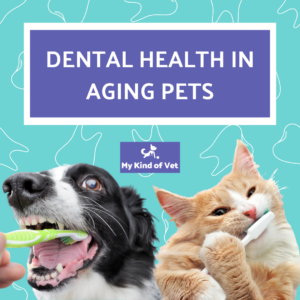
While aging is a natural process, factors such as dental hygiene, diet, and genetic predisposition can contribute to a buildup of plaque and tartar, and can ultimately lead to dental disease. Surprisingly, roughly 80% of dogs and cats develop dental disease by age three – four, making it more common than pet owners realise.
Dental disease is painful, can cause many health issues, and leads to a diminished quality of life.
Prevention is key: There are things you can do to help your pets dental hygiene and comfort:
- Use tartar build up minimising supplements like Plaque Away or Aquadent
- Brush your pet’s teeth
- Use dental chews or toys
- Feed dental foods
- Have regular dental checks with the vet
- Do full dental scale and polishes with the vet when required
Dental health is one of the most important aspects of your pets overall health so don’t let it go unchecked.
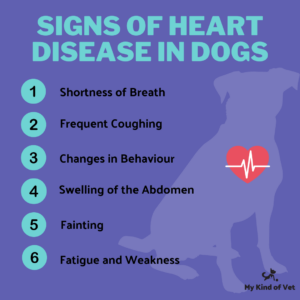
Common Conditions in older pets:
Heart Disease
Heart disease may be caused by variety of different reasons: heart valve degeneration, irregular heart rate and rhythm (arrhythmia), and heart muscle disease. Despite the many types of heart diseases affecting dogs, most share common signs that can alert owners to a problem.
Persistent Cough – In some dogs, fluid can accumulate in the lungs when the heart isn’t pumping efficiently. This backup of blood in the lungs can result in fluid leaking out of blood vessels and accumulating in lung tissue, resulting in cough. Other dogs may have heart diseases that lead to heart enlargement. The enlarged heart can press on airways and stimulate coughing. Any persistent cough that lasts more than a few days should be checked by a veterinarian.
Fainting or Collapse – When heart function is less than optimal, vital organs such as the brain can become deprived of nutrients, especially oxygen. Blood flow to the brain can be compromised in dogs with heart disease, leading to fainting (syncope) or collapse. Syncope and collapse in dogs with heart disease usually are triggered by exercise, although sometimes coughing can trigger an episode.
Difficulty Breathing – Dogs with heart disease often will have difficulty breathing (dyspnea). A dog may breathe more rapidly, or with more force. Some dogs will sit or stand with their legs wide apart and with their neck stretched out. Dogs with severe heart disease have more trouble breathing when lying down, and will often sit or stand for long periods of time.
Fatigue, Inability to Exercise – Dogs with heart disease will tire out more quickly on walks and during exercise. They may sleep or rest more than usual.
Tests Helpful in Heart Disease Diagnosis:
Chest X-ray
Electrocardiogram (ECG) – An ECG is the best way to detect an arrhythmia or abnormal heartbeat.
Echocardiogram
Blood Tests
Did you know that you can help your veterinarian treat your pet’s heart disease by counting their breathing rate at home, and watching for other clues that your pet is not doing as well as you think? Using simple techniques, you can learn how to become an invaluable part of your pet’s healthcare team.
Why should I evaluate my pet’s breathing rate at home?
An increase in your pet’s breathing rate while resting quietly or sleeping is a very important early clue (clinical sign) that your pet may be developing heart failure and needs to see your veterinarian. Your observations can help limit how sick your pet becomes, reduce the chances that your pet will ever have to stay overnight in the hospital, and help reduce the costs associated with heart failure treatment.
What is a normal resting or sleeping breathing rate in a dog and cat?
In general, all normal dogs and cats have a breathing rate of between 15-30 breaths every minute when they are resting calmly or sleeping. Lower rates are possible and are no cause for concern, providing your pet is otherwise acting normally. It is considered normal for breathing rates to be much higher than this when dogs and cats are hot, stressed, or active.
Resting/sleeping breathing rates that are consistently greater than 30 breaths per minute are increased and considered abnormal. For some individuals, rates lower than 30 breaths per minute may be considered increased and abnormal by your veterinarian. Ask your veterinarian what rate is considered increased and abnormal for your dog or cat.
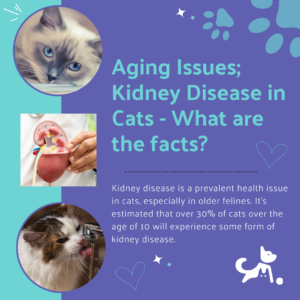
Common Conditions in older pets: Kidney Disease
Kidney Disease Facts in Cats
- Common Condition: Kidney disease is a prevalent health issue in cats, especially in older felines. It’s estimated that over 30% of cats over the age of 10 will experience some form of kidney disease.
- Chronic Kidney Disease (CKD): The most common type of kidney disease in cats is chronic kidney disease. This condition is progressive and may take months or even years to manifest noticeable symptoms.
- Silent Disease: In the early stages, cats with kidney disease may not show any noticeable symptoms. Regular veterinary check-ups and blood tests are essential for early detection.
- Dehydration and Thirst: Increased thirst and urination are common signs of kidney disease in cats. The kidneys’ reduced ability to conserve water can lead to dehydration.
- Weight Loss and Appetite Changes: Cats with kidney disease may experience a loss of appetite and gradual weight loss over time.
- Vomiting and Nausea: As kidney disease progresses, cats may experience nausea and vomiting.
- Bad Breath: Foul-smelling breath, often described as “urine-like” or “ammonia-like,” can be a sign of kidney disease due to the buildup of waste products in the body.
- Lethargy and Weakness: Cats with kidney disease may become lethargic, less active, and show a decline in overall energy levels.
- Increased Urination at Night: Cats with kidney disease may have an increased need to urinate, particularly during the night.
- Increased Blood Pressure: Kidney disease can lead to hypertension (high blood pressure) in cats, which may cause additional health problems.

Phosphorus and Potassium Imbalance: Kidney disease can disrupt the balance of essential minerals like phosphorus and potassium in the blood, potentially leading to further complications.
While kidney disease in cats is not always preventable, early detection and proper management can significantly improve their quality of life. If you notice any of these signs or suspect your cat may have kidney issues, seek prompt veterinary attention.
Let’s raise awareness about kidney disease in cats! Share these facts to help other cat owners understand the importance of early detection and proper care. Together, we can support our feline companions’ health and well-being.
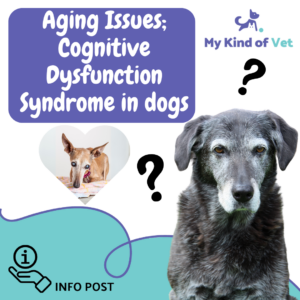
Common Conditions in older pets: Cognitive Dysfunction
Cognitive dysfunction syndrome (CDS) is a common age-related disease in dogs that affects the brain, causing deterioration similar to Alzheimer’s disease in humans.
Dogs may start to develop CDS around nine years of age, or older. The condition may be underdiagnosed since the behavioral changes progress slowly, and owners may assume that some changes are a normal part of aging.
Early intervention with environmental enrichment, diet and medical management can improve the quality of life for dogs affected by CDS.
Clinical signs
CDS may start as one clinical sign and progress over time, or have several apparent signs. The most common may include:
- Disorientation — Getting lost in familiar places, stuck in corners, staring into space
- Interaction changes — Suddenly clingy or avoidant, not recognizing familiar people
- Sleep pattern changes — Wandering the house at night, sleeping more during the day
- House-soiling — Urinating or defecating indoors when they were previously house-trained
- Activity level changes — Decreased interest in playing or doing other activities, restlessness, pacing
- Anxiety — Increased anxiety, new phobias, irritability, aggression
- Learning changes — No longer responding to previously known commands or struggling to learn new ones
If you think your pet may have cognitive dysfunction syndrome please see your vet for more information and treatment options
Myth Busting with Old Lady Pretzel:

